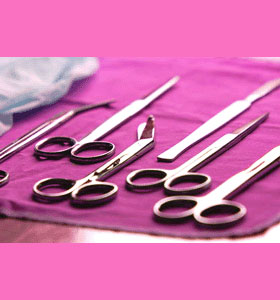
Plastic surgery risks and complications are an unfortunate part of the surgical process involved in many aesthetic and reconstructive procedures. Plastic surgery is generally considered to be one of the safest types of operation and is known for achieving positive results for patients with a wide array of problematic bodily conditions. Plastic surgeons are also some of the best trained of all medical professionals and are famous for their patience, precision and caring demeanor.
All positives aside, plastic surgery is still a risky endeavor. This resource section helps patients to recognize and prevent risk factors which may ruin their final aesthetic results.
Breast Implant-Related Plastic Surgery Risks
Although breast implants are generally safe, there is always the chance for experiencing some unforeseen problem or side effect from the augmentation operation. The most common surgical risks include:
Poor reaction to anesthetic might cause minor symptoms or life threatening complications. Pre-existing health conditions often increase these anesthetic-related risk factors.
Infection can occur from unsanitary operating conditions or postoperative contamination. Infection might be a mild annoyance or become a serious cause for concern.
Surgical side effects, such as nerve damage, vascular damage, glandular damage, hematoma, seroma or over dissection of tissue can occur due to even a small surgical error. These conditions are often considered iatrogenic problems which were caused by the surgeon, due to poor technique or lack of experience.
Bad cosmetic surgery can create an unaesthetic appearance of the operated area after any procedure. Sometimes the results are obviously not right, and other times, they simply might not measure up to the patient’s expectations. The best way to avoid becoming a victim of botched cosmetic surgery is to plan your procedure carefully.
Some procedures might go well and heal well, but still cause health concerns in the future. Ruptured breast implants and capsular contracture are the 2 most common examples of these types of complications.
Specific Surgical Risks
Plastic surgery infection is one of the most common of all complications that can occur during or after an aesthetic procedure. Likewise, cosmetic surgery infection is also commonplace and is certainly more prevalent during more invasive techniques.
Breast infection can occur for many reasons, including as a consequence of mammary surgery.
The risks of cosmetic surgery vary greatly, depending on many factors, including the type of procedure chosen, the skill of the doctor and the health of the patient.
Breast enlargement risks are greater with implant-based operations than with nonsurgical care practices.
Breast augmentation risks can revolve around the implants or the surgical technique itself.
Breast lift risks range considerably, since mastopexy comes in so many levels of invasiveness.
Reduction mammoplasty risks, also commonly known as breast reduction risks, are some of the worst in the plastic surgery sector.
Breast reduction complications can include scarring, loss of sensation, infection and many other possible negative effects.
Breast enlargement complications may be a direct result of the implants themselves or might occur due to surgical concerns during the placement procedure.
Cosmetic surgery complications can diminish the satisfying results of aesthetic operations.
Breast surgery iatrogenesis describes medical error that injures a patient during a mammary procedure. Meanwhile, iatrogenic cosmetic surgery is defined as medical error that injures a patient during general aesthetic surgery.
Breast implant risks are many and varied, but can be minimized through careful choice of prostheses.
Breast implant complications may include anatomical rejection, infection, migration, leaking or rupture, among others.
Bad breast implants can cause a world of mindbody problems for the affected patient.
Breast implant wrinkling is an unaesthetic complication that may require secondary revision surgery to correct.
Mondor’s cord is usually a temporary problem that may resolve all by itself, although some cases endure chronically.
Double bubble virtually always necessitates follow-up surgery to fix a problematic breast implant issue.
Synmastia occurs when breast implants migrate together, eliminating separation and cleavage.
Bottoming out occurs when implants migrate low into the breast, creating a saggy look and unnatural appearance.
Breast implant migration denotes movement of the implant prosthetics under the skin.
Ruptured breast implants require removal and replacement in every circumstance.
Remember, the dangers of cosmetic surgery can affect the mind, as well as the body.
Minimizing Plastic Surgery Risks
The best way to prevent any negative effects from your plastic surgery procedure is to be a knowledgeable and informed patient, who takes an active role in their own treatment. Learning the facts about all your surgical options will assist you in making the best choice of procedure for your needs. Researching doctors in great detail will help you to choose the very best surgeon for your chosen procedure. Getting in good shape and being prepared for the surgical process will help you to heal quickly and recover completely, with as little discomfort as possible. Finally, having good mental and emotional states will assist your body in fighting off infection, healing the wounds and resolving any painful symptoms which might occur after surgery.
Aesthetic Surgery Risk Advisory
Plastic surgery blends the worlds of art and medicine into a unique and therapeutic treatment. Aesthetic surgery holds so many rewards for patients who are affected by abnormal physical conditions. Patients might be under the care of their doctors, but they still have responsibilities. Patients must follow all their doctor’s advice and instructions in order to achieve a desirable final surgical result. The doctor can perform a flawless procedure, but after the operation is over, it is up to the patient to ensure good hygiene and proper aftercare for the operated region.
Never forget that the mind takes an active role in preventing all manner of complications. A strong will directed at healing the surgical wounds will speed the recovery process and achieve better results. A mind which fears complications, and has been frightened into believing something will go wrong, is likely to suffer actual physical effects as a direct result of the psychosomatic nocebo reaction. When it comes to preventing possible plastic surgery complications, a little positive thinking will actually go a long way.
Many people are not aware of the serious financial risk of balance billing when receiving care from a plastic surgeon in a hospital emergency room. We have no tolerance for this criminal behavior and will continue to advocate against it!
If you truly want to reduce your risks dramatically, learn how to achieve breast enlargement, lift or reduction nonsurgically. We provide expert advice on achieving the best results from nonsurgical breast enhancement products and practices in our critically acclaimed book: Better Breasts Without Surgery. Best of all, you can get help 24 hours a day from anywhere in the world.





